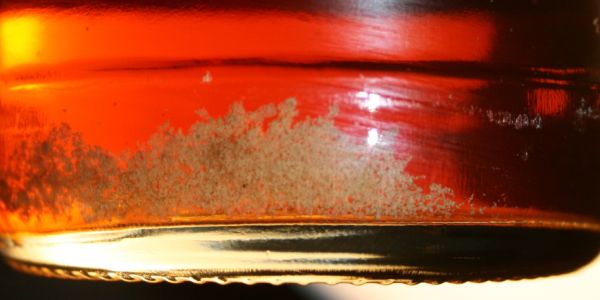What is the sediment, haze & precipitate material in very old, sherry matured whiskies and is it bad for you?
Rare Whisky and Sediment
David – With very old whisky oxalic acid has been leached out of the casks over an extended time period and this is particularly true when Spanish Oak Sherry casks are used and may thus cause a white crystalline precipitate to occur.
The science is well understood and can be explained that during the maturation period the oxalate ion precipitates out with calcium to form calcium oxalate (crystal deposits). With the addition of any calcium ions during addition of reduction water (to reduce the whisky ABV from natural cask strength to bottle strength) and any filtration and any other increase in pH that can occur during finishing and bottling it can take up to a year for the calcium oxalate to precipitate.
The complex nature of calcium oxalate instability that leads to precipitation is dependent on the temperature and alcohol concentration of the whisky. Since stable environmental conditions may only occur once the whisky is bottled and released commercially it can be hard to predict how these products will behave. And indeed, it may take months, if not years, for the crystal agglomerations to reach a size to be seen by the naked human eye.

The industry is well aware that many very old, sherry matured in origin single malts, can throw a crystalline precipitate of calcium oxalate. Many examples of this exist with Macallan Anniversary 25 years old, Macallan 30 years old, Dalmore 40 year olds, G&M vintage whiskies from the 1930s, 40s, 50s and 60s etc. It’s a very common occurrence and provides proof of the natural sherry matured, gently filtered long aged nature of the resulting product.
Customers must realise that we are dealing with a traditional product, made from natural ingredients, from which the alcohol produced is distilled and then filled to oak casks without any intervention that would detract from the final product quality.
Aged Scotch whisky may therefore be compared with fine port and some of France’s world famous clarets where, for example, significant precipitation occurs. Whisky may be decanted by the end user as one would a fine port or wine.
Ingestion of the calcium oxalate crystals would not pose any toxicity problems as calcium oxalate is found in many foods and drinks in far higher concentrations typically 1-10 mg/litre for whisky and 1400 mg/litre in chocolate and 330 mg/l in tea.
Andy – So that’s the why and how done; but does this sediment serve any other use?
It actually does.
With older bottles of heavily sherried whisky I always look for sediment to be present. While not definitive, as we’re dealing with many variables around the liquid and also how the bottle’s been stored, the presence of sediment is a good indication that the whisky is genuine…. Or at least it’s pretty old sherried stuff.
When I’m appraising a collection of older bottles, if I don’t see the ‘sludge-of-certainty’ it rings alarm bells and at least warrants digging a bit more into the provenance of the bottle.



